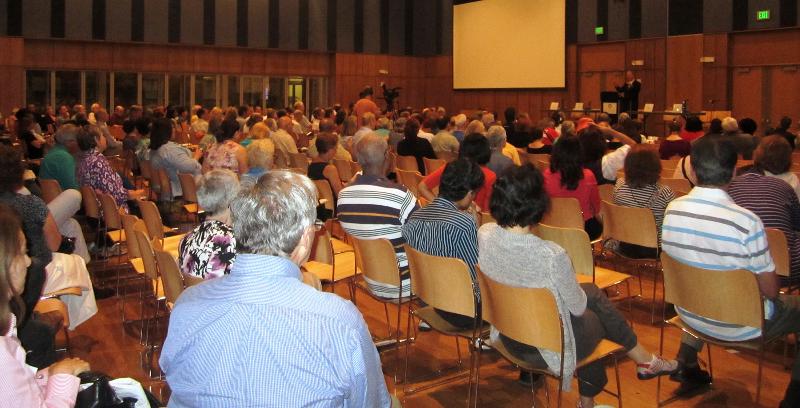|
SPECIAL SUMMER 2013 ISSUE
Community Updates |
|
|
Dear Readers,
 Our hat's off to you and our partners with the Trees Matter coalition. Your hundreds of e-mails and letters helped win groundbreaking tree legislation for Montgomery County! Congratulations to all of you who contacted the Montgomery County Council in recent months to express your views and make a difference in the outcome of the votes on Bill 35-12 (Montgomery County Tree Canopy Law) and Bill 41-12 (Streets and Roadside Tree Law). You spoke for the trees and the Council heard you. The bills were signed by County Executive Leggett on July 27th. A summary of each final bill follows the story below.
This is one battle won but there are other important issues for our local environment. In this issue, read how to weigh in on the effort to save one of the last pristine creeks in Montgomery County and an important backup source of our drinking water supply for the region -- Ten Mile Creek in Clarksburg. The buildout proposed in Stage IV of the Clarksburg Master Plan jeopardizes the quality of this stream. Enjoy the rest of your summer and stay tuned for updates on Ten Mile Creek and other issues.
-- Board of Directors, Conservation Montgomery |
|
 | |
Tree bills signed into law
County Executive Isiah Leggett (seated) signs tree legislation into law, surrounded by Trees Matter coalition representatives, DEP Director Bob Hoyt and Councilmembers |
Public outcry for better legislation prevailed
And the winner is....the tree canopy
Hundreds of people throughout Montgomery County spoke for the trees over the past seven months and the trees won. On July 23rd, the Council passed both the long-awaited Bill 35-12 and Bill 41-12 to address replacement of tree canopy and better protection for street and roadside trees.
On July 8th, the Transportation and Environment (T&E) subcommittee of the Council unanimously passed the urban canopy Bill 35-12 with Option 2 -- the stronger of two options presented by the Department of Environmental Protection (DEP) -- to send that version of Bill 35-12 to the full Council for a vote. But T&E Committee members heard again from developers between July 8 and the day of the vote. DEP had compromised with infill builders who opposed the legislation and removed what builders were calling a "tax" for removing tree canopy from building lots. However this was followed by T&E Committee members compromising more with builders and attempting to reverse course and support Option 1, which was favored by developers and offered less potential for replacing lost canopy.
On the day of the Council vote, an amendment drafted by Councilmember Nancy Floreen to reverse the T&E Committee vote and insert Option 1 was part of the Council packet. Councilmember Hans Riemer supported the Floreen amendment and moved to have the Council vote to replace Option 2 with the weaker Option 1 in Bill 35-12.
At Large Councilmember Marc Elrich voted against the Floreen amendment to Bill 35-12 and urged the Council to stand by the unanimous recommendation for Option 2 as passed by the T&E Committee on July 8. Councilmembers voting for Option 1 (Floreen amendment) were: Councilmember Nancy Floreen (At Large), Councilmember George Leventhal (At Large), Councilmember Hans Riemer (At Large), and Councilmember Valerie Ervin (Dist. 5).
 | |
Council President Nancy Navarro |
Council President Nancy Navarro was among the five members voting for the stronger option and presented a friendly amendment to concentrate replanting of trees in urbanized areas and communities where tree canopy is low. Her amendment was accepted and added to the final version of Bill 35-12 as well as to Bill 41-12.
The vote on Bill 41-12, the streets and roadside trees legislation, was preceded by lengthy discussion from Councilmembers Floreen and Leventhal. Both voted against the bill, disputing the need for the bill and saying that the 100-year-old state Roadside Tree Law and state oversight was sufficient.
Ultimately, Bill 41-12 passed 7-2 and Bill 35-12, with Option 2 intact and Ms. Navarro's friendly amendment, passed with a unanimous vote. Bill 41-12 was sponsored by Councilmembers Roger Berliner (Dist.1) and Councilmember Elrich. Bill 35-12 was sponsored by County Executive Isiah Leggett.
"Both of these bills were about doing what's best for the environment, so the stronger option on the canopy bill should have been an easy decision for the Council," said Councilmember Elrich. "If anything, the legislation could be stronger and on par with tree legislation passed by other jurisdictions. But this is a good start for the county."
Summaries of the bills:
|
 Planning Staff Report Presented in Preparation for Sept. 10 hearing Report could be revised before a Planning Commission vote
Two Save Ten Mile Creek Coalition rallies in July at the Planning Department brought together people from all around Montgomery County, including from Clarksburg, Boyds, and Silver Spring, along with Councilmember Marc Elrich, to urge the Planning Board and County Council to save our Last, Best Creek and protect it from degradation.
The creek is the cleanest source of water for the Little Seneca Reservoir, which is the Washington, D.C. region's emergency backup drinking water supply and is threatened by large development proposals by Pulte for a subdivision and by the Peterson Company's proposal for an outlet mall.
While the Montgomery Planning staff's July 18th recommendation would scale down the Pulte proposal, the report states that any development will ruin Ten Mile Creek as a reference stream. Your letters requesting full protection -- meaning no degradation of the water quality of Ten Mile Creek -- are needed during the month of August. Write to the Planning Board Chair, Francoise Carrier at MCP-Chair@mncppc-mc.org
The coalition will continue to organize a grassroots effort leading to the September 10th public hearing on the Planning Staff draft report. For more information: Visit savetenmilecreek.com For an analysis of the July 18th staff draft for Ten Mile Creek: savetenmilecreek.com/analysis  |
|
_____________________________________________________________
Town Hall Meeting Draws Hundreds of Montgomery Residents
to Discuss Need for Local Action on Climate Change
 | |
About 400 county residents gathered in the great hall of the Silver Spring Civic Center on Aug. 1 to hear how to take action on climate change policy |
About 400 county residents gathered on Aug. 2nd to hear a call to action led by Organizing for Action, the nonprofit supporting the President's agenda. The goal of a national campaign over the summer is to support the President's Climate Action Plan released in late June. Mike Tidwell of the Chesapeake Climate Action Network (CCAN) and other groups partnering with Organizing for Action led a successful event a the Silver Spring Civic Center.
Speakers included Congressman Chris Van Hollen, Dr. Donald Boesch, Vice President of the Maryland Center for Environmental Science and Vice Chancellor for Environmental Sustainability for the 12-institution University System of Maryland; Dr. Cindy Parker, a physician specializing in the health impacts of global climate change; and Katherine Magruder, Executive Director of the Maryland Clean Energy Center. Dr. Parker highlighted the list of climate-related illnesses that are occuring worldwide, such as West Nile Virus and heart and lung diseases.
"You may not be paying for dirty energy on your electric bill but you are paying for it with your health," Dr. Parker said.
Citing a recent study showing that that a majority of U.S. residents recognize that climate change is real, vs. a vocal minority who are naysayers, Van Hollen urged the audience to translate President Obama's recent speech on climate change into action. He pointed out that most of President Obama's action plan includes measures that he can accomplish with Executive Orders rather than Congressional action.
"An idea without action to translate it into reality doesn't get us anywhere," said Van Hollen. "Our challenge is to make sure we draw the real connection in the American mind as to the dangers of climate change." |
|
|
|
|
__________________________________________________
Quick Links... 
|
|
|
|
|
|